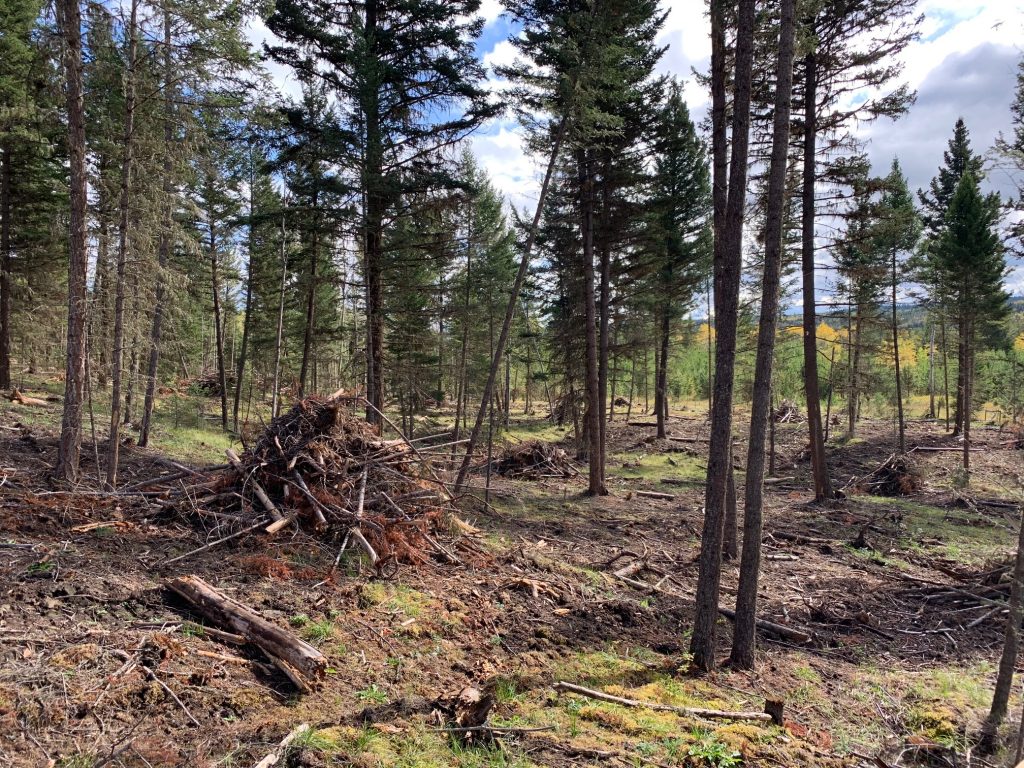
Industry News
News
Forestry Management
Harvesting
100 Mile House forestry projects reduce wildfire risk in interface areas
October 28, 2019 By Forest Enhancement Society of B.C.
 Photo by Ray Raatz (courtesy FESBC).
Photo by Ray Raatz (courtesy FESBC). The Forest Enhancement Society of B.C. (FESBC) is supporting three projects within the 100 Mile House Community Forest which will reduce wildfire risk in priority interface areas.
The 100 Mile House Development Corporation undertook a multi-phase project. The first phase assessed and identified wildfire risk and the second phase included the development of site-specific forestry. Implementation of various fuel management treatments falls under the third phase.
“In 2018, the focus of the 100 Mile Community Forest shifted from harvesting objectives to fuel management and fire break activities,” said Mitch Campsall, mayor, 100 Mile House. “We realigned our priorities to embark on an ambitious fuel management program with the help of FESBC.”
A phased project approach is important to ensure nothing is missed and the highest-risk areas are treated with the overall goal of achieving the surface fuel loadings desired by the B.C. Wildfire Service.
“It takes time to do a project like this well and to make sure you’re achieving all the operational goals and desired outcomes on the landscape,” said 100 Mile House resident Ray Raatz, RPF, FESBC operations manager. “The whole intention is to change fire behaviour, getting the fire to move from high-intensity crown fire to a low-intensity ground fire to make it easier to suppress or put out, thereby reducing the overall risk to the community. This project is consistent with FESBC’s purpose of wildfire risk reduction and mitigation and aligns with existing community strategies.”
FESBC approved $60,000 for the first project where 30 fuel break units within 1,125 hectares were assessed in areas surrounding the communities of 100 Mile House, Horse Lake, and Lone Butte. A second project saw more than $140,000 allocated toward prescription development and treatment activities adjacent to subdivisions in the Horse Lake Area.
The third project funded by FESBC for more than $1.1M will support the continuation of prescriptions and treatments on other priority areas identified in earlier planning work, with activities starting in 2019 and continuing into 2022.
“Funding from FESBC has been critical in all phases of this project,” said Campsall. “In fact, assessing, developing prescriptions, and treating these fuel treatment blocks would not be possible without the assistance of FESBC.”
The total area that will be treated over the four-year-period under these projects is estimated to be 345 hectares and operational treatments are planned for 260 hectares. Project activities include surveys, treatment prescription development, tree thinning, removal of small trees, removal of leaning trees and some lower branches, and reduction of some dead wood on the ground.
In the areas treated to date, the objective has been to create a shaded fuel break which will result in a more fire resilient stand that also conserves mule deer winter range habitat and retains old growth forest characteristics. Fire resiliency doesn’t mean a fire will be prevented, but rather that the forest is more likely to survive a fire. In dry forests, more frequent low-intensity fires (perhaps every five-35 years) are nature’s way of rejuvenating wildlife habitat and maintaining important ecological processes.
“We focused on the clumpy retention of mature trees as opposed to single-tree retention with the objective of creating both a shaded fuel break and reduced snow depth to facilitate movement of mule deer in the winter,” said Steve Capling, RPF, senior forester at Lac La Hache’s DWB Consulting Services Ltd. “Our overall goal was to develop a process for implementing mechanical treatments that can be used across a variety of landscapes and fuel types. This will make the process easier for machine operators in the future as there will be consistency in how mechanical harvesting can be used to create resilient stands across the landscape while managing for wildfire risk.”
Capling added that there are a lot of considerations to be made with projects of this scope and scale including mule deer winter range, old growth forest management, and maintaining visual and aesthetic quality for recreational users and travellers through the Highway 24 corridor. Project planning included several community meetings with area residents and the Canoe Creek and Canim Lake Indian Bands.
“It’s a real collaborative effort to get things done on the ground,” said Capling. “The community needs to be willing to take the initiative to take a project like this on, and we’ve not only been fortunate to have had this funding from FESBC, but we’ve also had great support from ministry staff and the community for the project.”
Print this page